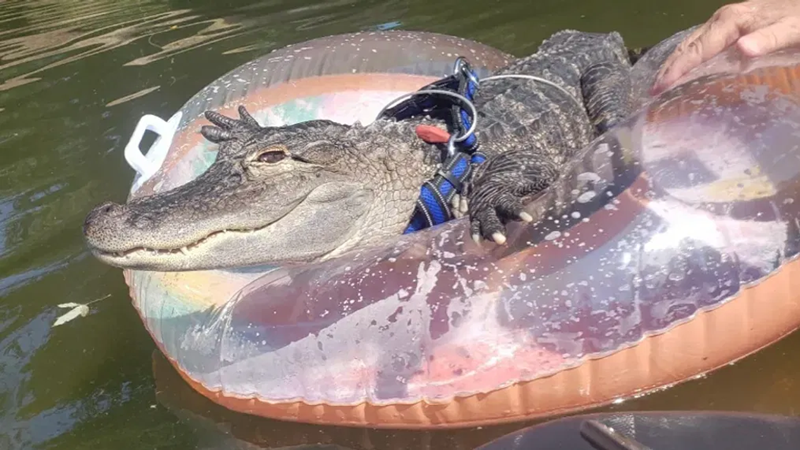In a heartwarming tale of resilience and compassion, an emotional support alligator found itself back in its natural habitat. The journey of this unique creature, fondly named Ally, began when she was discovered in dire conditions, far from the swampy surroundings she was accustomed to. As a surprising twist of fate, Ally ended up providing emotional support to a man who was battling his own mental health concerns.
The pair shared a unique bond that transcended the boundaries of species. The man, tormented by his internal struggles, found solace in the company of Ally, and the alligator, in turn, seemed to flourish under his care. Their story spread across the community, raising awareness about the therapeutic potential of unconventional pets. Despite the hesitation some people felt about the safety of having an alligator as a support animal, many marveled at the deep connection between the man and the reptile.
However, as Ally grew, so did the challenges of keeping her. The man’s residential environment was not equipped to accommodate a full-grown alligator, and Ally’s health was beginning to decline. A local wildlife rescue organization stepped in, recognizing the urgent need to relocate Ally to a more suitable habitat. The man, although heartbroken, understood that Ally’s wellbeing was paramount and agreed to the relocation.
The organization worked tirelessly to prepare Ally for her return to the swamp. They carefully monitored her health, ensured she was well-fed, and gradually introduced her to her new environment. The process was slow and meticulous, but it was essential to ensure that Ally could adapt to the swamp after spending so much time in a human-dominated setting.
Ally’s release day was filled with mixed emotions. While the man was saddened to say goodbye, he was comforted by the knowledge that Ally was returning to her natural habitat where she could thrive. The wildlife rescue organization documented the release, capturing the moment Ally slid into the swamp, disappearing beneath the water’s surface. It was a bittersweet moment that represented the culmination of a unique journey.
Ally’s story serves as a poignant reminder of the complex relationships that can exist between humans and animals. It sheds light on the therapeutic potential of unconventional emotional support animals and the dedicated efforts of wildlife rescue organizations to ensure the wellbeing of these creatures. Despite the challenges faced by both the man and Ally, their story ended with Ally returning to her rightful home, healthier and ready to embrace her new life.

Incident Overview
An Incident Overview is a comprehensive summary that provides detailed information about a particular event or situation. It includes the specifics such as the date, time, location, people involved, and sequence of events. It is a methodical documentation that aids in understanding the nature of an incident, its causes, and its effects. This overview serves multiple purposes across different fields.
For instance, in a corporate setting, it assists in assessing the impact of an incident on business operations, leading to effective decision-making processes. It can also aid in creating appropriate responses to prevent the recurrence of similar incidents in the future. On the other hand, in a healthcare setting, an Incident Overview can help in identifying any gaps in the system that may have led to a patient’s adverse event and in developing strategies to prevent such occurrences.
Academic researchers also utilize Incident Overviews to study human behavior or societal trends. It is important to note that an Incident Overview should present factual data without any bias or personal opinions. It should be written in a clear, concise manner and should be easily understandable for anyone who reads it. The information gathered in an Incident Overview can serve as a valuable resource for learning, improving systems, and shaping policies.
Rescue Operation
Rescue operations are critical interventions performed by trained professionals during emergencies to save lives and ensure recovery from threatening situations. They are often carried out in circumstances where individuals are in imminent danger, such as natural disasters, accidents, or other life-threatening situations. These operations can be complex and require the expertise of skilled individuals or teams, including firefighters, paramedics, and military personnel. They must act quickly and efficiently, often in high-stress and volatile environments, to secure the safety of those in peril. These operations are meticulously planned and executed with precision to ensure the maximum chance of success.
Moreover, rescue operations can also involve the use of sophisticated equipment and technology, such as helicopters, boats, and specialized rescue vehicles. These are particularly useful in situations where access to victims is difficult, such as in remote or mountainous regions, in the ocean, or in collapsed buildings. Additionally, rescue dogs are often utilized in these operations due to their extraordinary ability to detect people trapped under rubble or lost in wilderness areas.
One of the key aspects of any rescue operation is coordination. This involves the careful orchestration of various teams and resources to effectively manage the crisis at hand. Communication, therefore, plays a crucial role in ensuring all parties are kept informed and can respond appropriately as the situation unfolds. Furthermore, the psychological aspect of rescue operations cannot be overlooked. Support is often provided to victims to help cope with the trauma associated with their ordeal.
In conclusion, rescue operations are critical in safeguarding lives during emergencies. They require a high level of expertise, quick response, effective coordination, and the use of advanced equipment and techniques. These operations illustrate the incredible lengths that humans will go to protect and save one another in times of crisis.

Emotional Support and Controversy
Emotional support, particularly in the form of emotional support animals (ESAs), has become a topic of heated debate in recent years. On one side, proponents argue that ESAs provide invaluable comfort and assistance to individuals dealing with emotional or psychological conditions, such as anxiety, depression, or post-traumatic stress disorder. They believe these animals, which can range from dogs and cats to more exotic species like peacocks or miniature horses, offer a unique form of therapy that cannot be replicated by medication or traditional counseling methods.
On the other side, critics express concern about the potential for misuse and exploitation. They argue that the lack of stringent regulations surrounding ESAs allows virtually anyone to claim their pet as an ESA, often for the purpose of circumventing pet restrictions in housing or travel. There are also concerns regarding the impact of such animals on public health and safety, particularly when they are not properly trained or under control. Additionally, critics believe that the widespread use of ESAs can diminish the legitimacy and importance of service animals, which are trained to perform specific tasks for individuals with physical disabilities.
The issue has also brought attention to the role of mental health in society. Some people argue that ESAs are a symptom of an over-medicalized culture that seeks quick fixes for complex emotional issues. Others counter that ESAs represent a more holistic understanding of mental health and a recognition of the deep emotional bonds between humans and animals. These differing perspectives illustrate the complexity of the issue and the need for thoughtful discussion and policy-making. Regardless of one’s stance on the issue, it is clear that emotional support, in all its forms, plays a vital role in human wellbeing.
Return to the Wild
Return to the Wild encapsulates the compelling journey of creatures, once held captive or domesticated, as they regain their innate freedom by being reintroduced to their natural habitats. This process, often facilitated by dedicated conservation groups, involves meticulous preparation, acclimatization, and post-release monitoring. It’s important to remember that wildlife entities are integral components of our ecosystem and belong in the wilderness rather than confined spaces. The transition back to their natural environment can be challenging for animals as they have to relearn survival instincts and adapt to a different way of life. It is a process that requires patience, time, and extensive care.
However, the results of this endeavor are overwhelmingly rewarding, witnessing these creatures embrace their inherent wild instincts and integrate seamlessly into the ecosystem they belong to. They begin hunting or foraging for food, seeking shelter, and even forming social connections with other members of their species. This is a testament to the resilience and adaptability of these wild beings.
Yet, the return to the wild is not just about the animals. It also brings into perspective the role of humans in wildlife conservation. By facilitating this return, humans can help restore balance in nature, protect biodiversity, and contribute to the overall health of the planet. The journey also serves as an opportunity for people to educate themselves about wildlife and understand their needs better. The return to the wild is, therefore, a transformative experience not just for the animals who regain their freedom, but also for the humans who learn to respect and appreciate the wild for what it truly is. It’s about reestablishing the bond between humans and nature, and recognizing the value and beauty of wildlife in its natural state.

Resources and Support
Resources and support are fundamental elements in any sphere of life, be it personal, professional, or societal. The concept of resources encompasses a broad spectrum, including financial, educational, emotional, and technological facets. Resources, in the form of financial aid, can enable individuals and organizations to overcome monetary constraints and achieve their goals. Similarly, educational resources provide necessary knowledge and skills, contributing significantly to intellectual growth and development. Emotional resources, such as empathy, understanding, and motivation, play a crucial role in mental well-being, while technological resources are indispensable in the modern world, facilitating efficiency and innovation.
The term ‘support’ is equally multi-faceted. It can imply emotional backing from friends, family, or professionals, which is essential for maintaining psychological health. Support can also indicate professional assistance, such as mentorship or guidance, which can significantly enhance career progression. Moreover, societal support, reflected through policies, initiatives, and community help, can foster social welfare and cohesion.
Resources and support often intertwine, with each enhancing the effectiveness of the other. For instance, resources can be more efficiently and beneficially utilized with the right support. Simultaneously, the provision of support can be amplified with the aid of appropriate resources. Therefore, a holistic approach integrating both resources and support is crucial for individuals, organizations, and society to thrive.
In the globalized world, the accessibility of resources and support has expanded significantly, transcending geographical boundaries. Digital platforms and technologies have broadened the scope of available resources while also enabling a wider reach of support systems. However, disparities persist, with marginalized and disadvantaged groups often lacking adequate resources and support. Addressing these inequalities and ensuring the equitable distribution of resources and support is a pressing need of our times.
In conclusion, resources and support are integral aspects of life and society, with their significance transcending multiple domains. Their effective and equitable utilization can significantly contribute to progress, development, and well-being on multiple levels.
